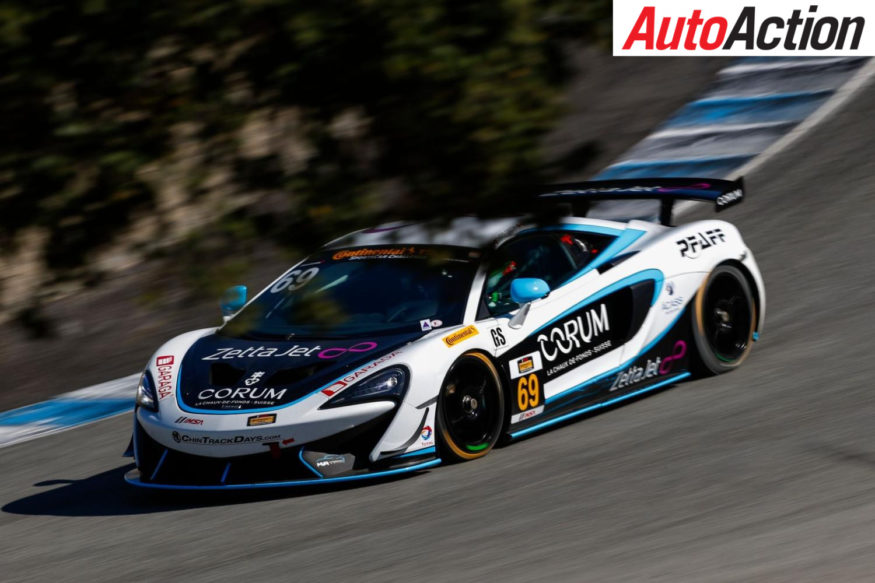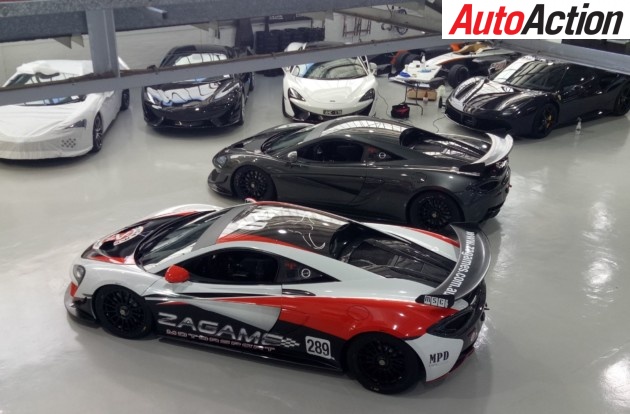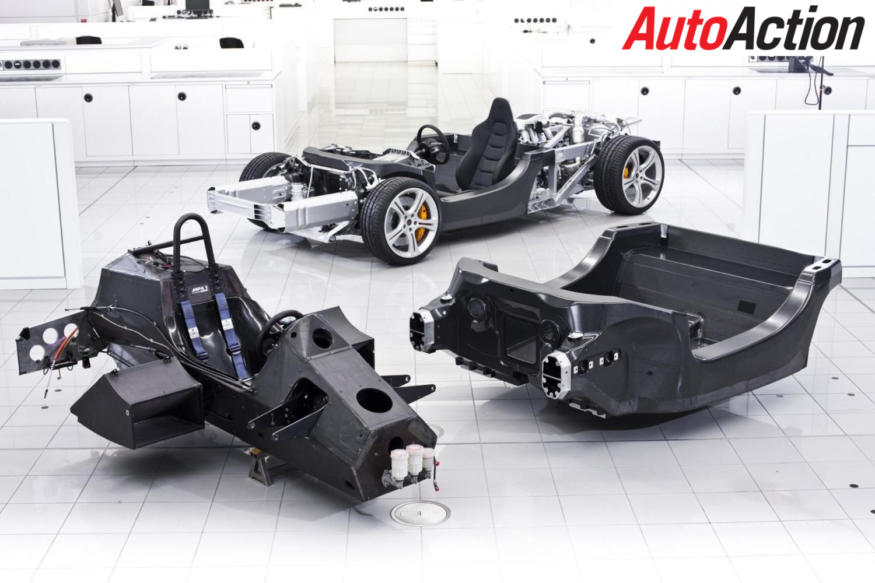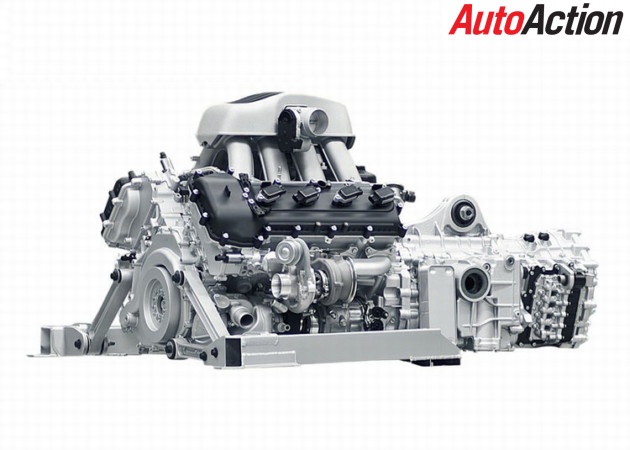UNDER THE SKIN: MCLAREN 570S GT4 – WOKING CLASS HERO

The GT4 category is expanding quickly – and McLaren wants to take a stake in the Australian scene, with its 570S GT4

Under The Skin of the new McLaren 570S GT4
ONE OF the interesting things about looking Under the Skin of racing cars is the wide variety of different ones we get to take a look at.
In the last two editions, AA has feature Liam Hill’s Hyundai Sports Sedan, which has elements of Nissan and Ford in its DNA, and is a one-off. On the other hand in the last edition we looked at Formula Vee which, for more than half a century, has encouraged budget-conscious racers to go their own way in the workshop so they can be competitive on the track.
At the opposite end of that scale is McLaren’s 570S GT4. One of the most famous brands in the sport spread its wings into road car production a decade ago, and racing versions of its cars followed shortly after.
This is, nearly, the ultimate, off-the-peg racer, for those wanting to get into GT competition at the entry level, or those who want an exotic and intoxicating Track Day car. And that is becoming an important area of the sport as other manufacturers like BMW, Porsche and even KTM, try to attract buyers with decent amounts to spend on cars that will not break the bank with their running costs.
McLaren is fast becoming one of the category’s leading lights. McLaren Technology has recently undergone a transformation, with the exit of founder Ron Dennis mid-year and a change in the way its GT program has been executed.

What was previously, in reality, a third-party program is now run in-house at McLaren’s Woking, UK base. The company sold 3286 cars in 2016, which does not sound like a lot (Porsche, for instance, sold 237,000). But that is double what it was the year before, and is within 200 sales worldwide of what Lamborghini sold in the same year.
And more is coming on the racing side. Already there is a ‘Sprint’ version of the 570S, which is specced slightly differently the GT4 and meant for Track Day drivers only. The successful 650S GT3 will be replaced by a 720S GT3 at the end of next season.
McLaren Automotive’s CEO, Mike Flewitt, said the addition of the 570S track models broadens the appeal of its GT racing division to less experienced racers while offering a more affordable entry into motorsport.
“As with road-going models wearing a McLaren badge, the 570S GT4 and 570S Sprint models are about being an engaging and exciting drive,” Flewitt said.
“The launch of the Sports Series has broadened McLaren to a new audience, introducing technologies to the sports car market and to a new group of customers. The 570S GT4 is doing the same in the motorsport world, and will bring the opportunity to own and race a McLaren – previously limited to a very small number of people – to a much wider group.”

McLaren 570S GT4 in Zagame’s workshop
But for now, GT4 is an active marketplace and Zagame Autosport, based in Richmond in Melbourne, has taken delivery of three of the cars this year.
Rob Crawford, former team manager of Kmart Racing, HSV Racing and the Holden Racing Team, oversees Zagame’s motorsport program, and sees a lot of pluses in McLaren’s 570S.
“One of the advantages is, if people want to buy a Track Day car, and they want to buy a Ferrari 488, for instance, the only thing available is a Ferrari Challenge car,” he says. “And if you get a Challenge Ferrari, you have to go and race it in Asia.”
Zagame’s first car arrived last January, and is maintained by veteran racer Peter Fitzgerald. Two more GT4s arrived just prior to Challenge Bathurst, where one of them took to the wet track in the hands of Victor Zagame.
“It has a very good service schedule,” said Crawford after the run, “and there have been no teething problems, none at all.
“The car has proven to be extremely reliable. It is very light on its brakes; that has worked out well.”
The car is interesting technically, but first, some history. McLaren has been building track versions of its road cars since 2011, when it rolled out the GT3 version of its original road car – of this generation, anyway. The GT3 version of the MP4-12C was unveiled at the end of 2011 and made its track debut the following season.

The McLaren 570S is based around the MonoCell II
That was followed by the racing version of the next model McLaren, the 650S which was, technically, an update of the older car. Two years ago, McLaren presented the 570S, based around the same MonoCell II carbon fibre monocoque. It weighs 75kg and is in use in a number of models, though the 570S is less hard-core than the 650S.
Behind the driver is a 3.8-litre twin-turbo V8 that, in road car trim, cranks out 562hp (419kW). In GT4 trim that is much less; factor in about 429 horses.
But if the car is to remain a Track Day only ‘racer’ it will not be subject to power restrictions – so in theory, all 562 ponies can be called upon…

The McLaren 570S GT4’s 3.8-litre twin-turbo V8 engine
One of the interesting things about the engine that it actually has its roots in Japan. In the late 1980s Nissan built a unit called the VRH for use in competition, a version of which found its way into its Le Mans cars in 1989. It was in use in the 24 Hour race as later as 1998, and in another incarnation Tom Walkinshaw Racing developed a version of the motor for an aborted Indycar project.
British engineering company Ricardo became involved and developed what McLaren now calls the M838 T E – in around 18 months.
Behind the V8 sits the transmission, built by Graziano in Italy – which also supplies units to the likes of Lamborghini, Bugatti, Aston Martin and yes, Ferrari. It has seven speeds, operated by paddle shift.

Even then, there are a lot of adjustments within the system. In Normal setting, the car has full ABS and Traction Control; in Sport, both functions are reduced; and in Track, both are further reduced, allowing for drivers of various skill levels to get to grips with the car.
Similar settings are available for the transmission as well, adjusting gearchange latency, the downchange ‘blip’ and shift points. The car also features launch control, in which mode the car’s ECU will take over the upchanges until the driver changes manually…
As you would expect, aerodynamic performance and cooling have been optimised, though the standard radiator remains, with larger ducting and an additional cooler. The road car does without the 650S’s movable rear wing, which would be illegal in GT racing anyway, so there is a custom rear wing and a full-width front splitter, both in carbon fibre.
Underneath the car’s bodywork, all of which is either aluminum or carbon fibre and, things remain simple.
“You can adjust the rear wing; you are allowed to do that on all the GT4 cars,” says Crawford. “You can adjust the dampers for bump and rebound, but the dampers and the spring rates are set. The roll bars have only two positional adjustments, plus your ride heights, cambers and tyre pressures.”
The other concessions to being a track car are minimal; the beefier-than-stock centre lock OZ Racing wheels give the car a wider track than the road car, and there is an on-board air-jacking system. Apart from that, there is a lot that is familiar; even the road car’s power windows and aircon still work…
So, the $64,000 question; how much?

The answer is not $64,000, and there is more than one answer to the question. The reason for that is, Zagame can provide the GT4 in a variety of forms – not the car itself but the level of support that the customer wants.
“We can provide everything, you bring your helmet,” says Crawford.
“You bring your helmet and we do everything else; store the car, service it for you, deliver it to the track. You show up with your kitbag, walk out and drive it. We will go through the data for you; we supply a driver coach and a data engineer to help the drivers.
“It has a V-Box system, which is quite good, it supplies a lot of good vision.”
One thing though; the cost of the car is nothing like McLaren’s GT3 car.
“The cars are a fair bit cheaper than a GT3 car. For the gentleman driver, they are a lot easier to drive than a GT3 car, because they are much less dependent on their aero. It’s more mechanical grip. With a GT3, you need a fair bit of… commitment to getting the best out of it.
“With a GT4 car, you still need to have commitment but it is less aero-dependent, and that makes it predictable.
“We have had three for four enquiries about it, and they are out there making their decisions about next year soon.”
Is McLaren as emotional a brand as Ferrari? No. But Porsche? Lamborghini? Aston Martin?
Maybe, maybe not.
The form of the McLaren Grand Prix team during the Honda years has left a lot to be desired. But McLaren’s supercars and GT racers are carving out their own niches in the marketplace and on the tracks.
Seen any orange T-shirts lately? At the Bathurst 12 Hour, don’t be surprised if you do…
McLaren 570S GT4 Tech Specs
(Homologation Code GT4-030)
Chassis
McLaren carbon fibre MonoCell II chassis
Aluminium front and rear frames and crash structures
FIA-Approved Roll Cage
Body
Aluminium and carbon fibre panels
Dimensions
Wheelbase 2674mm
Track F/R 1647mm/1581mm
Length 4608mm
Height 1201mm (doors closed)
Width F/R 1903mm/1915mm
Minimum Weight 1425kg
Engine
3799cc M838TE V8 DOHC with twin turbochargers
Power 429ps @ 7000rpm
Torque 470Nm @ 5500-6000rpm
Transmission
7-Speed Seamless Shift by Graziano
Paddle operation
Cooling
Standard 570S plus additional front center high-temperature radiator
Aerodynamics
Unique front splitter and floor assembly
Front dive planes
GT4-specification adjustable rear wing
Axle
Centre-lock integrated hub and wheel bearing unit
Handed side to side with secondary wheel retention mechanism
Brakes
Non-adjustable balance
Bosch ESP 9 ABS
Rotors
F/R 370mm x 32mm/350mm x 30mm
Callipers
F and R Four-piston McLaren callipers
Wheels
Cast OZ Racing magnesium rims
9″x18″ front / 11″x18″ rear
Tyres
Pirelli racing tyres:
Front – 265/645-18″
Rear – 305/680-18″
Suspension
Motorsport adjustable dampers with coil-over springs
Seats
Winged headrest – FIA Approved 8855 spec
(Passenger seat optional)
By PHIL BRANAGAN
Article originally published in Issue 1726 of Auto Action.
For our latest Under The Skin feature pick up the current issue of Auto Action Magazine, on sale now. In the meantime follow us on social media Facebook, Twitter, Instagram or sign up for our weekly email newsletter for all the latest updates.


